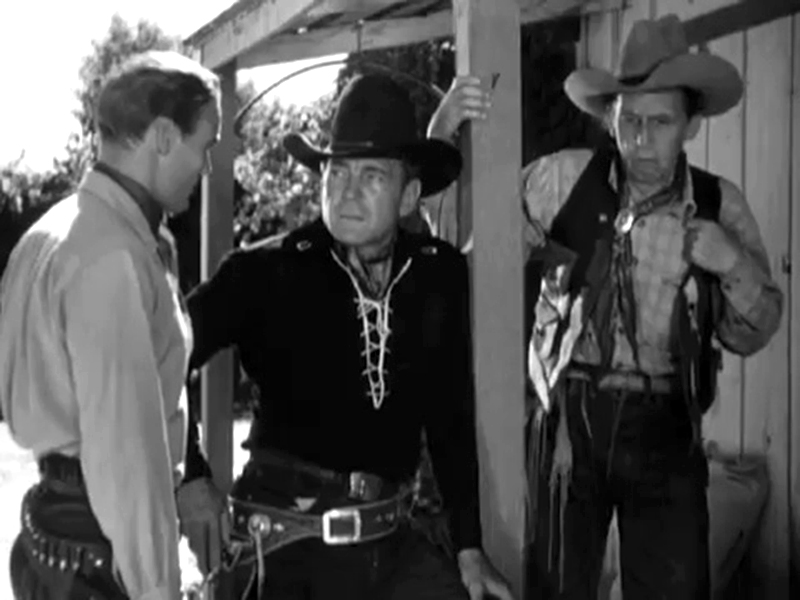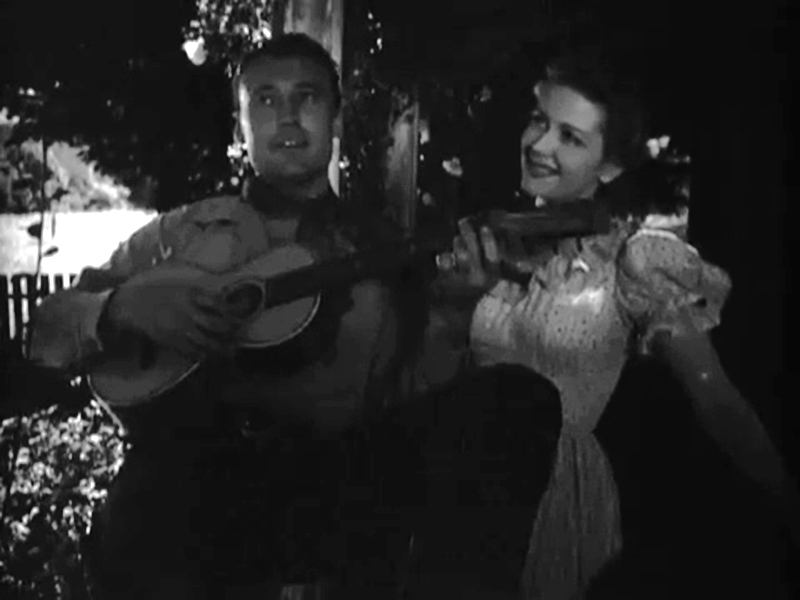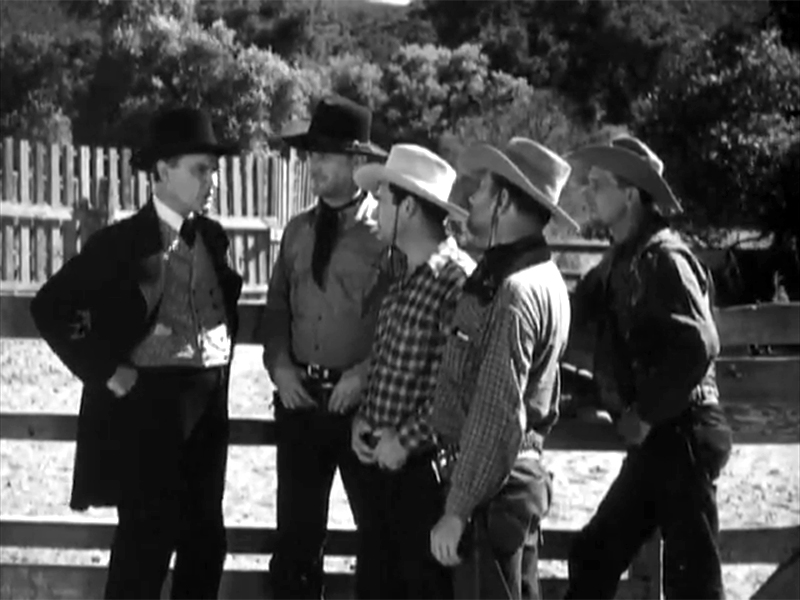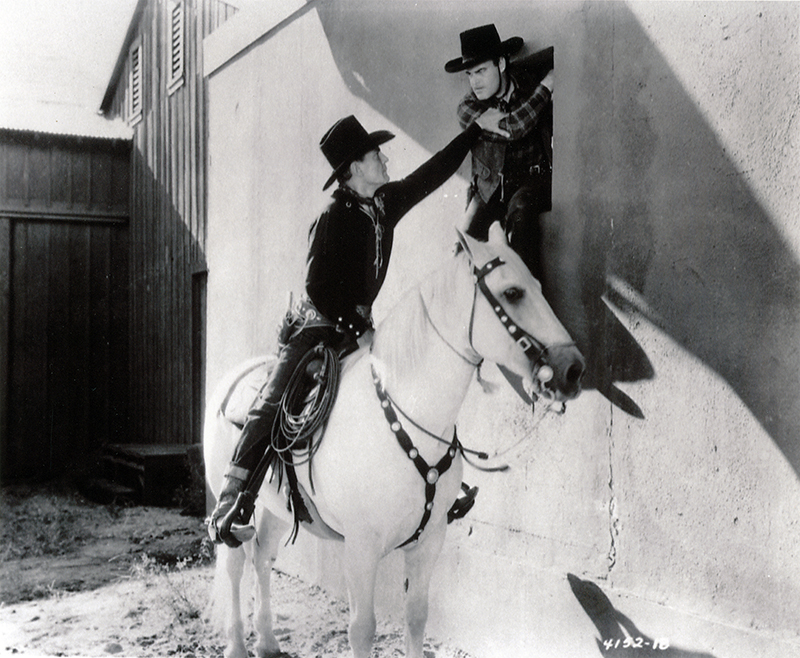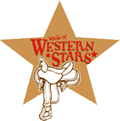|
|

|
Three men and a baby: Buck Jones, Tim McCoy and Raymond Hatton — Monogram's Rough Riders — team up to stop a dastardly rancher from jumping other ranchers' water rights — and rescue an orphaned infant in the process — in the 1941 buddy picture, "The Gunman from Bodie." Principal filming was done at Andy Jauregui's movie ranch in Placerita Canyon. In the 1940s, when the box-office appeal of the big stars of the 1920s and 1930s such as Hoot Gibson and Buck Jones began to fade as their original audiences aged and outgrew them, Monogram producer Scott Dunlap teamed them up in dozens of in low-budget ("B" Western) "buddy pictures" in an attempt to triple the attraction. The arrangement would ultimately lead to a twist ending for Buck Jones (see below). Christine McIntyre is the distressed damsel and Robert Frazer is the ruthless "Wyatt" in our picture, which also features Dave O'Brien, Charles King, Lynton Brent, Max Waizmann, Gene Alsace, John Merton, Frank LaRue and Jones' horse Silver. Uncredited cast includes Ed Brady, Kernan Cripps, Earl Douglas, Frederick Gee, Chick Hannan, Warren Jackson, Jack King, Merrill McCormick, Tex Palmer and Jerry Sheldon. Stunt performers are Alsace, Jack Hendricks and Wally West. Monogram regular Harry Neumann was behind the camera, and Glen Glenn handled the sound.
About the Andy Jauregui Ranch. The Andy Jauregui Ranch, originally the Clarence "Fat" Jones ranch, was located just east of present-day Highway 14 along Placerita Canyon Road. In its day (the 1930s), the Jones Ranch was next door to Trem Carr's original Monogram Ranch. Carr's original leasehold formed the nucleus of The Walt Disney Co.'s Golden Oak Ranch in the late 1950s. The Jauregui Ranch was actually owned by Standard Oil and leased to Jauregui — a major purveyor of stock and performers for rodeos, and an equestrian stuntman in the movies. According to Schneider Vol. 4 (2015:63), "In 1933, Jauregui bought out Jones' share when Jones moved his horse rental business to North Hollywood. The ranch buildings and ranch house were all actual working buildings for the ranch. Chevron permitted the Jaureguis, Andy and his wife Camille, to remain on the property until they were either dead or no longer resided on the property." Andy Jauregui died in 1990, followed by Camille in 1996. Per Schneider (op. cit.), Chevron razed all of the buildings on the land except for the ranch house. The property was then sold to its neighbor, the Golden Oak Ranch of Walt Disney. It wasn't an isolated instance. In the mid-1990s Chevron got rid of all of its nonproducing properties. Locally that included Mentryville in Pico Canyon and the Pioneer Oil Refinery property in Railroad Canyon, Newhall, among others. Further reading: Andy Jauregui biography by his daughter, Noureen Baer Inside Story of the Rodeos by Andy Jauregui, Popular Mechanics 6/1935.
About Buck Jones. The Life and Untimely Death of Buck Jones. Buck Jones was an A-lister among the "B" Western actors of the 1920s-30s-40s. A popular hero of dime novels and comic books, promoter of Grape-Nuts cereal and Daisy air rifles, Jones frequently starred in films shot at Placerita Canyon and Vasquez Rocks, and he came out of retirement during the war, when younger stars were off serving, to co-star in eight "Rough Riders" buddy pictures for Scott R. Dunlap at Monogram (after Dunlap had made a mid-career move in the 1930s to serve as Jones' business manager). The end of Jones' career didn't come by choice. He died as a result of traumatic burn injuries sustained in the famous Cocoanut Grove fire of Nov. 28, 1942, the deadliest nightclub fire in U.S. history. Flames started downstairs and quickly spread through the Boston nightclub; a single revolving door was the only way out. Jones was counted among the 492 casualties when he died at a hospital two days later. Jones was at the Grove because Dunlap was throwing a party in his honor. Dunlap was seriously injured but survived. Monogram exec Trem Carr was credited (or blamed) for spreading the rumor that Jones sustained his fatal injuries when he rushed back into the burning building to rescue victims, but in fact Jones was trapped behind a wrought-iron railing that incapacitated him in his seat directly across from the bandstand. Born Charles Frederick Gebhart on Dec. 12, 1891, in Vincennes, Ind. — some sources erroneously say Dec. 4, 1889 — he joined the U.S. Army in 1907 at age 16 and earned the Purple Heart during a rebellion in the Philippines. Discharged in 1909, he pursued and interest in auto racing and went to work for Marmon Motor Car Co. He reenlisted in the Army in 1910 and served until 1913, after which he busted broncs on the Miller Bros. 101 Ranch in Oklahoma where he met his bride, Odille "Dell" Osborne. The outbreak of World War I saw him training horses for the allies. Later, a Wild West Show took him to Los Angeles where he got work at Universal as a $5-a-day stuntman and actor. He went to Canyon Pictures and then to Fox Film Corp., earning $40 a week for stunt work. Fox eventually used him as a backup to Tom Mix, raised his salary to $150 a week, and gave him his first starring role in 1920's "The Last Straw." By the mid-1920s he was at least as big a star as Mix, Hoot Gibson or Ken Maynard. In 1928 he formed his own production company, but it was ill-timed. The silent period was closing and Westerns fell into a brief decline; and when the stock market crashed the following year he lost his shirt. He then tried to form his own Wild West show but it, too, failed, and after a year away from the screen, Jones landed at the Poverty Row studio Columbia Pictures at $300 a week, a fraction of his top silent-era salary. (Columbia hadn't yet broken out with 1934's "It Happened One Night.") Westerns roared back in the 1930s and Jones did, too. His masculine voice caught on with audiences as he starred in pictures for Columbia and Universal which were often shot in the Santa Clarita Valley. At one point he received more fan mail than any other actor. The early 1940s saw him co-produce a string of movies with his friend Dunlap, who teamed him up with Tim McCoy and Raymond Hatton to form the Rough Riders. Further reading: Buck Jones, Bona Fide Hero by Joseph G. Rosa, 1966.
|
Story by Andy Jauregui 1935
Andy Jauregui & Wm. S. Hart 1938
Andy Jauregui Bio by Noureen Baer 1978
Profile: Andy & Camille 1984
Jauregui's 1934 Saugus Rodeo Ribbon
Branded Pitcher
Tim McCoy in The Man from Guntown 1935
The Ivory-Handled Gun 1935 (Mult.)
FULL MOVIE: The Gunman from Bodie 1941
Gene Autry in The Singing Hill 1941
Forbidden Trail 1941
Eddie Dean in Tumbleweed Trail 1946
Randolph Scott in Trail Street 1947
Gene Autry in Strawberry Roan 1948 x3
Alias Jesse James 1959 (Mult.)
Canadian Club Ad 1969
|
The site owner makes no assertions as to ownership of any original copyrights to digitized images. However, these images are intended for Personal or Research use only. Any other kind of use, including but not limited to commercial or scholarly publication in any medium or format, public exhibition, or use online or in a web site, may be subject to additional restrictions including but not limited to the copyrights held by parties other than the site owner. USERS ARE SOLELY RESPONSIBLE for determining the existence of such rights and for obtaining any permissions and/or paying associated fees necessary for the proposed use.
